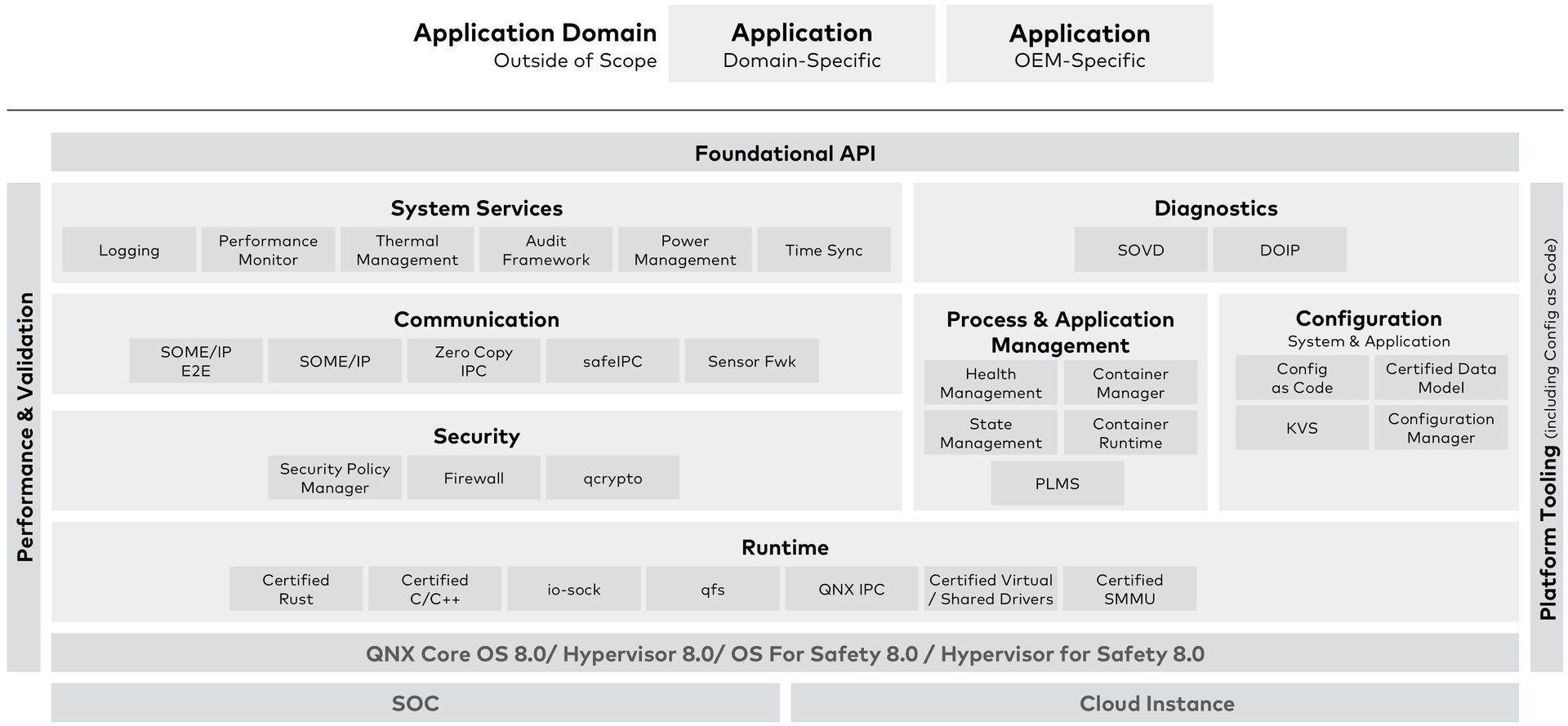Engineered for Integration
The foundational vehicle software platform unifies the proven technologies of QNX and Vector with innovations developed specifically for this platform, offering more than the sum of its parts. It integrates essential components including the foundational operating system and virtualization technology from QNX, and robust middleware from Vector.
With a focus on delivering a highly optimized platform for runtime execution, safety, and security certification at the system level, OEMs can streamline development, reduce integration overhead, and concentrate on creating differentiating in-vehicle experiences. The foundational vehicle software platform is a lightweight technical platform with a simplified approach to system configuration and standardized application development for deployment across various ECU types.
Designed to evolve with industry needs, the foundational vehicle software platform is shaped by real-world insights to guide product direction, architecture, and use case priorities. This isn't just a platform; it's a commitment to driving the future of vehicle software through integration and automotive leadership.
Architecture of the Foundational Vehicle Software Platform

At its core is the QNX OS for Safety or the QNX Hypervisor for Safety 8.0, supplemented by certified runtime environments (e.g., Rust, C/C++) and Inter-Process Communication (IPC). The architecture is clearly layered: system services such as logging, power management, and time sync are accessible via the Foundational Vehicle Software Platform API.
Communication functions such as SOME/IP, safeIPC, and Zero Copy IPC ensure efficient data transfer. Integrated security functions – including firewall, qcrypto, and Security Policy Manager – meet the highest Cybersecurity requirements. Process and application management enable flexible control of vehicle functions through containerization, health monitoring, and state management. Standardized interfaces (SOVD, DOIP) and tools based on the configuration-as-code paradigm are available for Diagnostics and configuration.
Benefits
- REDUCED INTEGRATION EFFORT
- SINGLE POINT OF CONTACT
- PERFORMANCE OPTIMIZATION
- COLLABORATION OPPORTUNITY
- SAFETY & CYBERSECURITY
SINGLE POINT OF CONTACT
PERFORMANCE OPTIMIZATION
COLLABORATION OPPORTUNITY
SAFETY & CYBERSECURITY
Benefits
-
REDUCED INTEGRATION EFFORT
Simplifies the development of Software-Defined Vehicles with a pre-integrated, modular platform. The foundation, platform services and tools work together seamlessly, eliminating the need for time-consuming coordination between different software suppliers. This speeds up the development process and reduces costs throughout the entire life cycle. -
SINGLE POINT OF CONTACT
OEMs retain the flexibility to engage with the provider of their choice, while still benefiting from a cohesive and integrated solution, ensuring streamlined support without the complexity of managing multiple vendors. -
PERFORMANCE OPTIMIZATION
The deeper integration of the operating system and middleware creates a high-performance environment for modern HPC applications. By reducing the load on the overall system, efficiency and response times are increased, which in turn enables OEMs and automotive suppliers to reduce costs by optimizing the hardware used. -
COLLABORATION OPPORTUNITY
OEMs and partners will gain direct access to the foundational software platform’s source code, enabling them to actively collaborate and contribute to its ongoing development. -
SAFETY & CYBERSECURITY
Meets the highest safety standards according to ISO 26262 (ASIL D) and ISO 21434. Security and data protection aspects are an integral part of the architecture and are ensured by certified software modules.

